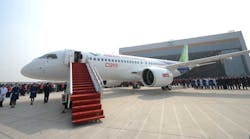Last month’s maiden test flight by China’s homegrown C919 passenger jet has one U.K. plastics maker reaching for the skies.
Victrex Plc supplied the polyetheretherketon, a thermoplastic used in fuel brackets on the aircraft wings that can save as much as 40% on weight. Just as Airbus SE has replaced an aluminum fitting on its A350 doors with the material -- also known as PEEK -- Commercial Aircraft Corp. of China Ltd. could present a similar “raft of opportunities” for the U.K. company, Chief Executive Officer Dave Hummel said in an interview in London.
Although mass production is still at least two years away, Chinese authorities are seeking agreements on airworthiness with U.S. and European regulators to open the way for flights outside China. Comac had orders and commitments from 23 mostly Chinese buyers for 570 airplanes as of late 2016, with China Eastern Airlines Corp. due to take first delivery as soon as 2019.
“Just because you can fly a plane, doesn’t mean you can fly a passenger jet with 200 people on board, but I would never discount what Comac can do,” the CEO said. “It’s like when you initially had the Koreans and Americans saying that only they can do smart phones and not the Chinese. Well, the next thing you know the Chinese manufacturers are there.”
Victrex is hoping the inaugural flight of C919 over Shanghai on May 5 will prove a double winner, giving it an edge over competitors Solvay SA of Belgium and Germany’s Evonik Industries AG encroaching on its other PEEK markets, including smart phones and medical implants. The jet could also spur the incumbent duopoly of Airbus and Boeing Co. to embrace lightweight plastics and composites more, speeding up manufacturing in the process, Hummel said.
PEEK content on the Comac is currently lower than on planes by established peers, including Airbus’ A320neo. The Chinese had to limit the amount of new innovation on board the C919 to get a prototype off the ground so it could move on to issues of reliability and production, according to Hummel.
By hiring Airbus and Boeing engineers and tapping supply chains in place for decades, the Chinese avoided having to start from “ground zero,” Hummel said. Engineers in Russia are also developing a single-aisle passenger jet that relies heavily on composites.
Lightweight Parts
While Comac plays catch up, Airbus and Boeing are taking a deeper look at their production lines to work out how manufacturing times and order backlogs can be shrunk and weight saved, Hummel said.
“Comac is looking to get a high-end plane flying, while Boeing and Airbus are looking ahead to what’s next as they already do that -- their biggest concern is that they can’t get enough planes out of the door,” Hummel said. “The tough thing for Comac is to stay up where technology is. At some point, you almost have to say let’s stop innovating and just assemble.”
Chinese companies are also working out how to manufacture PEEK, a notoriously difficult polymer to make, according to Bernstein analysts Gunther Zechmann and Jeremy Redenius. To assess the competitive threat, the analysts purchased a few kilograms of PEEK on Alibaba Group Holding Ltd.’s retail platform and carried out nuclear magnetic resonance, spectroscopy and differential scanning calorimetry tests. They found Chinese PEEK to be “good, but not perfect,” the analysts said in a note.
“Entrance barriers due to quality, security of supply, service and customer qualification remain high,” Zechmann and Redenius said. “Technically, however, Asian players are catching up rapidly. Commercially, they are beginning to gain a foothold in the market.”
Victrex, based near Blackpool, England, supplies the materials used to build the wing tips on planes. It’s also moved into manufacturing whole polymer-based parts through a joint venture with Tri-Mack Plastics Manufacturing Corp. It’s seeking more partnerships and acquisitions to add additional expertise in fibers and composites, Hummel said.
“When we go to the likes of Boeing with these products they say, ‘Great, where can we get the parts made?’ and that’s why we did the Tri-Mack joint venture,” the CEO said. “There are a lot of different things we’re looking into.”
by



